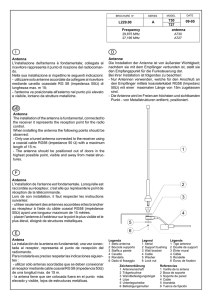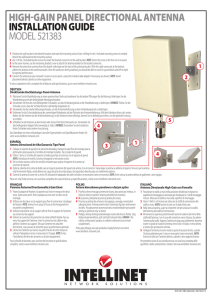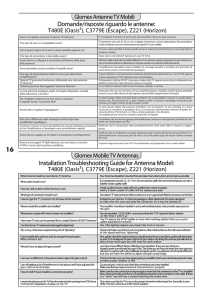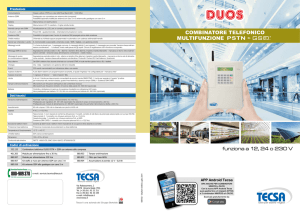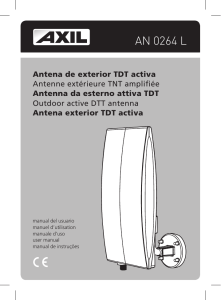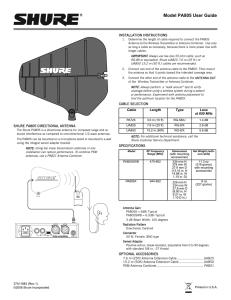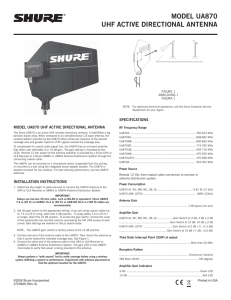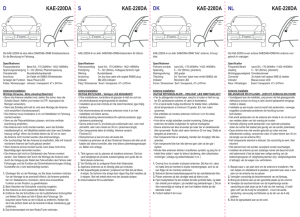6. MIMO Antennas for Mobile Terminal.show
Anuncio
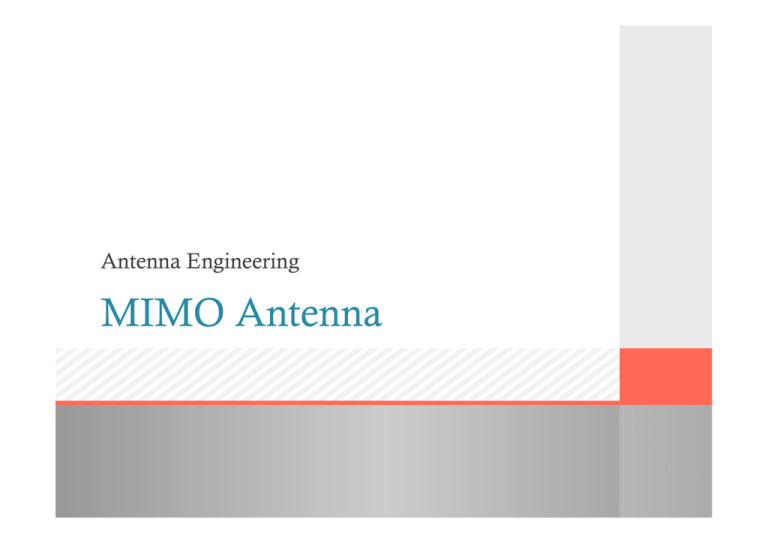
Antenna Engineering MIMO System MIMO Antenna 2 Wireless standards and MIMO MIMO Antenna 3 SISO and Multipath Fading MIMO Antenna 4 Multiple Antennas improves Signal Quality MIMO Antenna 5 Multiple Antennas improve capacity MIMO Antenna 6 Antenna Polarization MIMO Antenna 7 Cross Polarization MIMO Antenna 8 Correlation coefficient MIMO Antenna 9 Mean Effective Gain MIMO Antenna 10 MEG Ratio MIMO Antenna 11 MIMO antenna design parameters Low envelope correlation between antennas Low envelope correlation can result from having sets of antenna patterns that are diverse in the spatial, phase and polarization senses. In order words, if all antenna patterns are "looking" in different directions or in di fferent ways(phase/polarization) one has low correlation. Large individual antenna mean effective gain (MEG) MEG refers to the gain of an antenna in particular environment relative to some reference antenna (e.g. isotropic radiator). In order words, it is a measure of how well an antenna receives power for a particular scatterin g environment. All antennas with roughly the same mean effective gain The MEG of each antenna needs to be roughly the same for a balanced system Low total array reflection coefficient (TARC) Antennas radiate simultaneously and must have minimal crosstalk pairs MIMO Antenna 12 2x2 MIMO Antenna Design The typical antenna specification for 2x2 MIMO has the following goals; Number of independent antenna ports: 2 Radiation efficiency : As high as possible Gain balanced ratio (ratio of the gain at each antenna port) : As high as possible, approaching 1 Correlation coefficient (envelope correlation coefficient between the two antenna ports) : As low as possible, approaching 0 MIMO Antenna 13 Diversity Gain MIMO Antenna 14 Correlation in free space MIMO Antenna 15 Correlation with Scattering object MIMO Antenna 16 Correlation over distance MIMO Antenna 17 Diversity Gain MIMO Antenna 18 Antenna placement (2-antenna array) MIMO Antenna 19 Single Antenna Design (f=2.6GHz) MIMO Antenna 20 Placement Investigation (s-parameters) MIMO Antenna 21 Mutual coupling (2-1) MIMO Antenna 22 Mutual coupling (2-2) MIMO Antenna 23 Mutual coupling (2-3) MIMO Antenna 24 Mutual coupling comparison MIMO Antenna 25 Correlation coefficient comparison MIMO Antenna 26 MIMO Antenna Design MIMO Antenna 27 MIMO Antenna Design MIMO Antenna 28 MIMO Antenna Design MIMO Antenna 29 MIMO Antenna Design MIMO Antenna 30 MIMO Antenna Design MIMO Antenna 31 LTE handset antenna design MIMO Antenna 32 LTE handset antenna design MIMO Antenna 33 LTE handset antenna design VSWR: <2:1 Efficiency: 30-40% Patterns almost identical Coupling: CC: >0.8 -4dB MIMO Antenna 34 LTE handset antenna design MIMO Antenna 35 LTE handset antenna design VSWR <2. 2:1 Efficiency 50-58% CC: <0.35 Isolation: <-13 dB Significantly different patterns results in low envelope correlation coefficient MIMO Antenna 36 Ex) MIMO Antenna Design Ground Surface Current and Isolation Actually position on ly is not enough Preferable position Antenna surface current distribution Type A antenna current -9dB isolation MIMO Antenna Type B antenna current -11dB isolation 37 Ex) MIMO Antenna Design Type 1 Type 2 MIMO Antenna 38 Ex) MIMO Antenna Design Current distribution with slot on the ground Current induci ng coupling Current mag nitude Current suppre ssed Short end MIMO Antenna Open end 39 Ex) MIMO Antenna Design 1/4 slot on PDA ground size 30db suppression MIMO Antenna 40 Ex) MIMO Antenna Design MIMO Antenna 41 Ex) MIMO Antenna Design 1.Without slot 2.With 2.4GHz only 3.With 5.2GHz only 4.With dual slot MIMO Antenna 42 Ex) MIMO Antenna Design MIMO Antenna 43
